Thoroughly analyzing TS Inter 2nd Year Commerce Model Papers and TS Inter 2nd Year Commerce Question Paper March 2016 helps students identify their strengths and weaknesses.
TS Inter 2nd Year Commerce Question Paper March 2016 with Solutions
Time: 3 Hours
Maximum Marks: 100
Part – I (50 Marks)
Section – A
(2 × 10 = 20)
Answer any TWO of the following questions not exceeding 40 lines each.
Question 1.
What is a Stock Exchange? Explain its functions.
Answer:
Introduction:
Stock exchange is an organized secondary market, where the listed securities are bought and sold by the investors.
Definition:
“Stock exchange is an association, organization or body of individuals, whether incorporated or not, established to assist, regulate and controlling business in buying, selling and dealing in securities”. – The Securities Contracts Act 1956
“Security exchanges are marketplaces where securities that have been listed thereon may be bought and sold either for investment or speculation”. – “Pyle”
Functions of Stock Exchange:
- Provides infrastructure for trading: In the stock exchange, instantaneously trading gets executed. It draws investment by providing a ready and continuous market for securities.
- Provides Information Regarding Prices: It gives sensible information through reliable sources and publishers to investors about the prices of securities. The proposed investor knows the quotation and the investor knows the price of his holdings.
- Protects Investor’s Wealth: It protects the interests and wealth of investors through the enforcement of its rules and regulations.
- Clearing House: Without a clearing house one will find a lot of trades mismatched. It acts on behalf of both buyer and seller and helps in the trading of securities.
- Provides Liquidity: The holder of securities can easily encash the securities by selling them to the buyer whenever he wants.
- Helps to Raise New Capital: The requirement of additional capital of an existing company can be raised by issuing the rights shares, through the stock exchange.
- Acts as a Barometer: An efficient stock exchange acts as a Barometer of business conditions in the country.
- Increases Creditworthiness of the Company: A company that got its shares to be listed on the stock exchange enjoys a good reputation.
- Minimizes the Dangers of Speculation: By following the rules and regulations of the Acts, it minimizes the dangers of speculative dealings and price manipulations.
- Facilitates Speculation: Stock exchange facilitates speculation thereby businessmen can speculate and earn profits from fluctuations in security prices.
![]()
Question 2.
Define banking and explain the functions of banking.
Answer:
Bank is derived from the French word “Banco” which means a Bench. It is believed that the early bankers, the Jews of Lombardy transacted their business on benches in the marketplace.
Definition:
“Banking is defined as accepting for lending or investment, of deposits of money from the public, repayable on demand or otherwise and withdrawable by cheque, draft, order or otherwise”. – Banking Regulation Act 1949 – Section 5 (1) (b)
Functions of Banks:
The core functions of a bank are
- Acceptance of money deposits from the public.
- Lending (or) making advances to the public.
- Undertaking Agency Services.
- Rendering General Utility Services.
1. Acceptance of Deposits:
Banks accept money from the public in various forms which constitute borrowings by banks. The deposits are one of the main sources of funds for the banks.
2. Lending (or) Making Advances to the Public:
Banks lending the deposit”amounts. It is a profit motive. The bank will not lend the whole of the deposits it keeps a certain amount to meet contingencies and the remaining portion is lent to the business community at a higher rate of interest. The difference between the rate of interest allowed and deposits and the rate charged on the loans is called as ‘spread’, it is the main source of income for a bank. An advance is a credit facility provided by a bank to its customers. It is generated for shorter periods. Further, the purpose behind granting an advance is to meet the day-to-day requirements of a business.
3. Agency Functions or Services:
Banks perform these functions for their customers. These are
- To collect or pay bills, cheques, interest, dividends, rent, etc., on behalf of customers. For rendering these services, banks collect charges from their customers.
- To act as executor, trustee, and attorney on the customer’s will.
- To work as a correspondent, agent, or representative of their clients.
4. General Utility Services:
These services are provided to the general public. These are
- A letter of credit may be issued by the bank at the request of the importer to the exporter.
- Bank drafts and traveler’s cheques are issued to provide facilities for fund transfer from one part of the country to another part.
- Acceptance or collection of foreign bills of exchange.
- Banks arrange safe deposit lockers for the safe custody of customers’ securities, valuables, and jewelry.
- Other general public utility services.
Question 3.
Explain the contribution of Henry Fayol in the field of management.
Answer:
Henry Fayol (1841 – 1925):
Henry Fayol was a French mining engineer who later turned into a leading industrialist and a successful manager. His lifelong experience, in the field of managing, was produced in the form of a monograph titled”. ‘Administration industrielle-et-generale’ in 1916 in the French language. This monograph was reprinted in French several times but was never translated into English until – 1929. Fayol’s contribution to the science of management may be summarised as follows:
- Classification of industrial activities.
- Classification of managerial functions.
- Universal principles of management.
- Significance of management function.
- Managerial qualities and training.
- Macro approach to management.
- The human aspect of management.
Henry Fayol has been rightly called “The father of management”. He has identified 14 principles of management those are division of labor, authority and responsibility, discipline, unity of command; unity of direction; subordination; remuneration; centralization, scalar chain, order, equity, stability of tenure; initiative; esprit-de-corps, etc.
Section – B
(4 × 5 = 20)
Answer any FOUR of the following questions not exceeding 20 lines each.
Question 4.
What are the differences between the Primary Market and the Secondary Market?
Answer:
| Concept | Primary Market | Secondary Market |
| 1. Nature | It is concerned with the issue of new shares. | It is concerned with the marketing of existing shares. |
| 2. Sale of Securities | It enables the company to sell securities to the investors directly or through intermediaries. | It helps the holders of securities to exchange their securities. |
| 3. Capital Formation | It is directly connected with the promotion of capital formation. | It is indirectly connected with the promotion of capital formation. |
| 4. Securities Dealing | It deals with the buying of securities. | It enables both buying and selling of securities. |
| 5. Value of Securities | It enables the management of the company to decide the value of the securities. | It enables the demand and supply to determine the price of securities. |
| 6. Location | It has no fixed geographical location. | It is located at specific places. |
Question 5.
Explain the functions of Entrepreneurs.
Answer:
The functions of Entrepreneur are:
1. Innovation:
Innovation is also different from invention. Invention implies the discovery of new ideas, new articles, and new methods, whereas innovation means the application of inventions and discoveries to make new and desired products and services that can be successfully sold in the market.
2. Risk Bearing:
Entrepreneurs in the game of business where risks and rewards are plenty will be ready to accept them.
3. Organisation and Management:
As rightly said by Alfred Marshall organization and management of the enterprise is the main function of an entrepreneur. He makes required alternations in the size of the business, its location, techniques of production, etc. The entrepreneur also undertakes managerial functions like formulation of production plans, organization of sales, and personnel management.
4. Business Planning:
The entrepreneur must provide logical and scientific basics for planning the business operations, the need for raw materials and men, production schedules, etc. For systematic business planning, the entrepreneur must be able to formulate goals, policies, procedures, programmes, and budgets.
5. Decision Making:
Another important function discharged by the entrepreneur is decision-making. He has to make decisions regarding the activities of the enterprise.
![]()
Question 6.
Explain the special support extended by the Government of Telangana to the SC/ST entrepreneurs in our state.
Answer:
Special support to SC/ST entrepreneurs is offered through TS-PRIDE. Some of the activities are as follows:
- A special direct funding program for financing SC/ST entrepreneurs.
- Payment of margin money on behalf of SC/ST entrepreneurs by the Government and creation of ₹ 5 crores for margin money refund scheme.
- Preferential allotment of plots in industrial parks.
- Supplier diversity opportunities in large industries.
- State departmental procurement policy in tune with GOI’s SME procurement policy of 20%.
- Organizing intensive entrepreneur and skill development:
- Subsidy eligibility if funded by CRISIL-rated NBFCs.
- Representation in all the districts and state-level committees.
Question 7.
Distinguish between Home trade and Foreign trade.
Answer:
| Home Trade | Foreign Trade |
| 1. Refers to the trade within the country. | 1. Refers to trade with other countries. |
| 2. There will be no restrictions. | 2. Subjected to many restrictions. |
| 3. Does not involve any exchange of currencies. | 3. Involves the exchange of currencies. |
| 4. There is scope for the operation of demand and supply forces. | 4. The scope for the operation of demand and supply forces is restricted. |
| 5. Transport costs and risks are less. | 5. Transport costs one more and risks are many. |
| 6. It facilitates the movement of goods from points of production to areas where they are consumed in the home country. | 6. It facilitates countries to specialize in manufacturing a particular line of products which enables them to sell those products across the globe. |
| 7. It helps to derive the benefits of specialization within the country. | 7. It helps all trading countries derive the benefits of specialization. |
| 8. The movement of goods depends upon the development of an internal transport system, especially road and rail. | 8. The movement of goods usually by road, rail, air, and water transport. |
| 9. The volume of trade depends upon the size of the population volume of production, and the development of banking and other supporting facilities. | 9. There are restrictions imposed on the size of the population volume of free entry of goods and duties and production, and development of banking taxes are to be paid. The volume of and other supporting facilities. Trade depends on this factor. |
Question 8.
Explain the merits and demerits of Road Transport.
Answer:
Merits:
- Cheapness: All forms of animal-driven, man-driven, and motor-driven transport are cheaper compared to the other forms.
- Safety: Damage due to the handling of goods is lesser in this form of transport.
- Flexibility: This advantage could be claimed only by road transport. It may go the place of loading and delivery of goods at the place of use.
Demerits:
- Irregular Operation: Most of the transporting systems operating on roads are not coordinated.
- Limited Carrying Capacity: Limited load-carrying capacity is one of the drawbacks of road transport.
- Slow Speed: Speed is an essential element in marketing but it is not possible in road transport.
- Rates: The rate structure is often oscillating in character.
Question 9.
What are the steps in the process of organizing?
Answer:
The process of organizing are following steps:
1. Identification and Division of Work:
The first step in the process of organizing involves identifying and dividing the work that has to be done by previously determined plans. The burden of work can be shared among the employees.
2. Departmentalization:
Once work has been divided into small and manageable activities then those activities which are similar are grouped. Such sets facilitate specialization. This grouping process is called departmentalization.
3. Assignment of Duties:
It is necessary to define the work of different job positions and accordingly allocate work to various employees. Jobs are then allocated to the members of each department by their skills and competencies.
4. Establishing Reporting Relationships:
Merely allocating work is not enough. Each individual should also know to whom he has to take orders and to whom he is accountable. The establishment of such clear relationships helps to create a hierarchical structure and helps in coordination among various departments.
Section – C
(5 × 2 = 10)
Answer any FIVE of the following questions not exceeding 5 lines each.
Question 10.
Define Consular Invoice.
Answer:
It is a document, which enables the importer to obtain prompt clearance of goods at the part of destination.
Question 11.
Write about the Endowment Policy.
Answer:
It runs only for a limited period or upto a particular age. The policy money becomes due at the end of the period specified in the policy. In case, however, the assured dies before the specified time the policy money is paid at the time of death.
Question 12.
Write short notes on Bonded warehouses.
Answer:
These warehouses are located near ports. It is the warehouse that enables the importer and exporter to store their goods according to their convenience.
![]()
Question 13.
Explain Adoptive Entrepreneur.
Answer:
He is one who instead of innovating new things, just adopts the successful innovations innovated by others.
Question 14.
What is a Project Report?
Answer:
It is the document prepared by the entrepreneur where he has to put his ideas and other information in black and white.
Question 15.
Write about Cheap Jacks.
Answer:
Cheap jacks, the other form of itinerant traders operate their business from small hired shops for a specified period. They keep moving from place to place.
Question 16.
What is a Bill of Lading?
Answer:
It is an official receipt of the shipping company acknowledging the receipt of goods on board.
Question 17.
Define Organising.
Answer:
Prof. Urwick defines “Organization as determining what activities are necessary to any purpose and arranging them in groups which may be assigned to individuals”.
Part – II (50 Marks)
Section – D
(1 × 20 = 20)
Answer the following question.
Question 18.
Anitha and Swathi are partners sharing profits and losses in the ratio of 2 : 1 respectively. Their balance sheet as of 31.03.2015 was as follows:
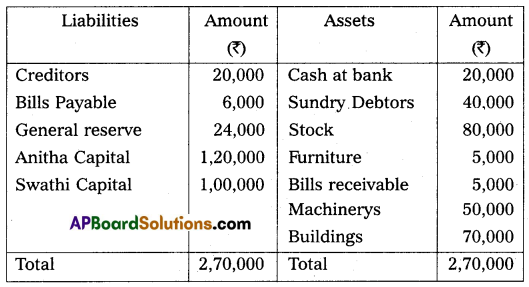
They decided to admit Miss. Sony as a partner on the following terms and conditions:
(i) Sony has to pay ₹ 1,25,000 as capital for 1/4th share in future profits.
(ii) Sony shall pay ₹ 30,000 as Goodwill, used only firm.
(iii) Machinery be depreciated by 10%.
(iv) Buildings to be appreciated by 20%.
(v) Provide for bad debts @ 6% on debtors.
Pass necessary ledger accounts and give the balance sheet of the new firm.
Answer:

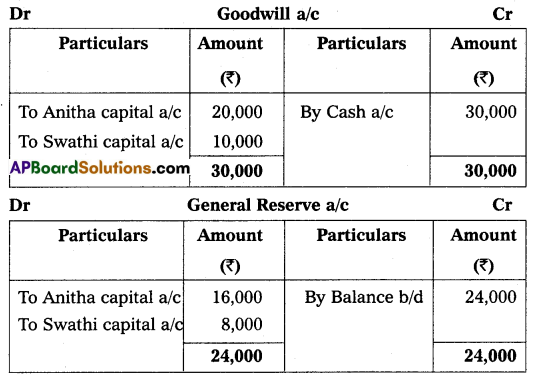
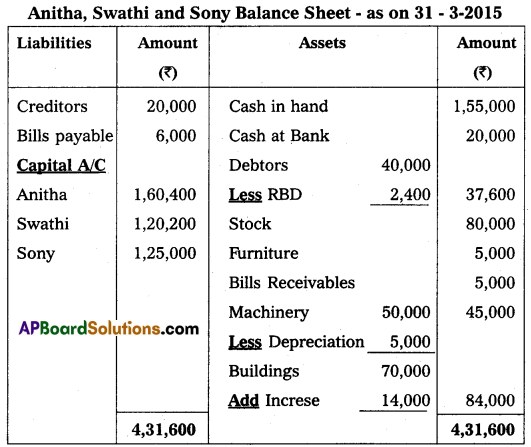
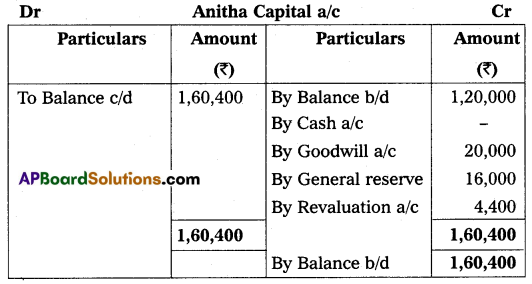

Section – E
(1 × 10 = 10)
Answer any ONE of the following questions.
Question 19.
Vaishnavi of Hyderabad consigned goods valued at ₹ 30,000 to Jahnavi of Delhi. Vaishnavi paid cartage and other expenses ₹ 2,000. Jahnavi sent the account sales with the following information:
(i) 50% of the goods sold for ₹ 22,000.
(ii) Jahnavi incurred expenses amounting to ₹ 1200.
(iii) Jahnavi is entitled to receive commission @ 5% on sales.
A bank draft was enclosed for the balance. Prepare the necessary ledger accounts in the books of Vaishnavi.
Answer:
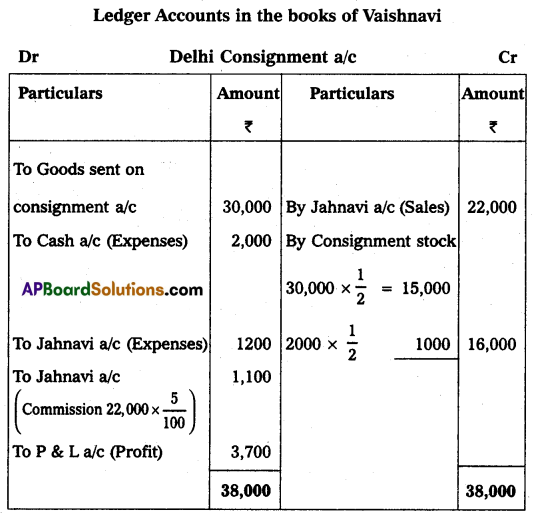


![]()
Question 20.
From the following information, prepare the income and expenditure account for the year ended 31-03-2015 of Warangal Town Club:

Additional Information:
(i) Subscriptions received included an amount ₹ 4,200 related to the previous year.
(ii) Outstanding subscription ₹ 1000.
(iii) Sports materials opening balance ₹ 4,000 and closing balance ₹ 5,000.
Answer:
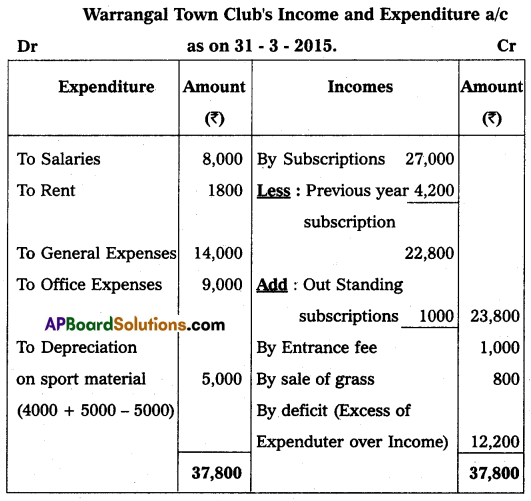
Section – F
(2 × 5 = 10)
Answer any TWO of the following questions.
Question 21.
What are the differences between consignment and sale?
Answer:
| Point of Difference | Consignment | Sale |
| 1. Parties | There are two parties here consignor and consignee. | There are two parties here: The seller and the buyer. |
| 2. Ownership of Goods | The ownership of the goods does not transfer from consignor to consignee. | The ownership of the goods is transferred from the seller to the buyer. |
| 3. Relationship | The relationship between the consignor and the consignee is the principal and agent. | In case of credit sale the relationship. |
| 4. Account Sales | The consignee sends the account sales to the consigner. | The buyer need not send the account sales to the seller. |
| 5. Return of Goods | The consignee can return the unsold stock to the consigner. | The buyer cannot return the goods to the seller. |
| 6. Risk of Loss of Goods | In case the goods are destroyed, the consignor has to bear the loss. | In case the goods are destroyed after the sale, the buyer has to bear the loss. |
| 7. Profit/Loss | The profit/loss belongs to the consignor. | The profit or loss on sales belongs to the seller. |
| 8. Order/Indent | There is no order from the consignee. | There must be an order from the buyer to the seller. |
Question 22.
Siddhartha bought a plant and machine on 1st April 2012. For ₹ 2,300 and paid ₹ 2,000 for its installation. Depreciation is to be allowed at 10% under the straight-line method. On 31-03-2015 the plant was sold for 18,000. Assuming that the account is closed at the end of the financial year. Prepare plant and machine a/c.
Answer:

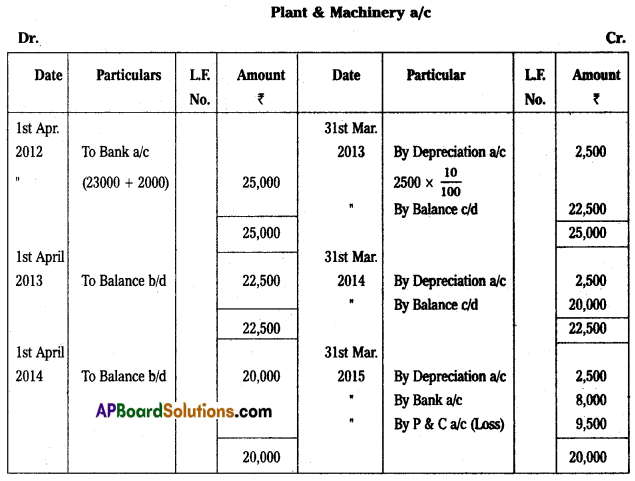
Question 23.
From the following information prepare a statement of affairs and find out the profit earned by Mr. Sravanthi who keeps his book under a single-entry system.
Capital at the beginning of the year: ₹ 12,000
Capital at the end of the year: ₹ 18,000
Drawing during the year: ₹ 4,000
Further capital introduced during the year: ₹ 5,500
Answer:

Question 24.
Define Computerised Accounting. Explain its future.
Answer:
Computerized accounting is nothing but replacing the manual accounting system of maintaining the books of account with the use of relevant software packages for accounting on a computer. As its name suggests “Computerised Accounting” is an accounting done with the support of a computer. It tends to involve dedicated accounting software and digital spreadsheets to keep track of a business or client’s financial transactions. Features of Computerised Accounting are:
1. Fast, Powerful, Simple and Integrated:
Computerized accounting is developed to automate and integrate all accounting transactions. All the accounting information, that is recorded will be at the fingertips of the user. It is very simple to operate with a greater speed.
2. Total Visibility:
The company will have greater visibility into the day-to-day business operations.
3. Improved User Free Experience:
Computerized accounting permits companies to enter data in various ways. It makes the work a pleasure. The company can adopt specific company needs with this feature.
4. Accuracy and Error-Free:
Computerized accounting provides users with definable templates with which they can get accurate and error-free data within no time as and when the button is clicked by the user.
5. Scalability:
Computerized accounting is designed to meet the current and future needs of the companies irrespective of their size and style.
6. Supremacy:
Computerized accounting is capable of storing huge volumes of transactions with greater retrieval capacity and efficiency.
7. Improved Business Performance:
Integrated and enhanced features of computerized accounting cover accounting, inventory, and reporting.
8. Rapid Decision Making:
Critical management information system reports instantly to make appropriate decisions at the right time.
9. Absolute Reliability:
Computerized accounting provides accurate critical financial information.
Section – G
(5 × 2 = 10)
Answer any FIVE of the following questions.
Question 25.
What is Obsolescence?
Answer:
Diminution (reduction) in the value of fixed assets due to new inventions, new improvements, changes in fashions, and changes in customers’ tastes and preferences.
![]()
Question 26.
What is the Delcredere Commission?
Answer:
Remuneration or additional commision paid to the consignee for taking the responsibility of collecting the amount on credit sales made by him.
Question 27.
Write a short notes on Legacy.
Answer:
Legacy It is the amount received by the organization as per the “will” of a person.
Question 28.
Write about the Tally Accounting Package.
Answer:
Tally is a versatile and massive software package. It is used by various types of trade and industry. Tally’s software business was set up in 1986 by the late S.S. Goenkar, who was the founder of the company Peutronics Private Ltd. Bangalore. His son Bharat Goenkar is the original architect and programmer of the tally accounting system and also the developer of the “No-Code” concept of accounting entries.
Tally is user-friendly software used to solve all the complicated accounting structures. Tally is a globally recognized name with 2 million users in over 90 countries experiencing the “Power of Simplicity”. Tally maintains ledger-wise balance and displays net debit or credit balance, for a ledger. Using a reverse journal to make transient journal vouchers to get intermediate profit and loss accounts and balance sheets. Tally offers numerous options for interest calculation. While the simple mode meets the needs of average users, the advanced mode is meant for users having complex requirements and penal interest.
Question 29.
Calculate closing capital as of 31-3-2015, opening capital as of 1-4-2014 is ₹ 26,000, and loss increased during the year is ₹ 5,000.
Answer:
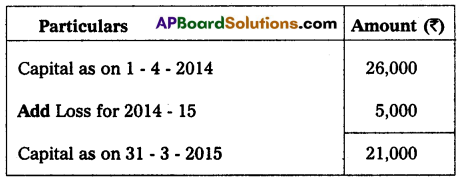
Question 30.
What is the Gaining Ratio?
Answer:
On the retirement of a partner from the partnership business, the remaining or continuing partners stand to gain. Because the share of profit enjoyed by retiring partners hereafter will be enjoyed by continuing partners. Therefore the continuing partners will benefit. The benefit or gain may not be equal. Therefore it is necessary to calculate the ratio in which the continuing partners gain on the retirement of a partner.
Ratio of Gaining = New Ratio – Old Ratio
Question 31.
P and Q are partners sharing profits and losses equally. They decided to admit ‘R’ for 1/5th share of profit in the business. Calculate the New profit sharing ratio of P, Q & R.
Answer:
The old Ratio of Paid Q is 1 : 1
‘R’ Share (given) = \(\frac{1}{5}\)
Remaining Share = 1 – \(\frac{1}{5}\) = \(\frac{4}{5}\)
New Ratio of P = \(\frac{4}{5} \times \frac{1}{2}=\frac{4}{10}\)
New Ratio of Q = \(\frac{4}{5} \times \frac{1}{2}=\frac{4}{10}\)
New Ratio of R = \(\frac{1}{5} \times \frac{2}{2}=\frac{2}{10}\)
New Ratio of P, Q, R = \(\frac{4}{10}: \frac{4}{10}: \frac{2}{10}\) = 4 : 4 : 2 = 2 : 2 : 1
![]()
Question 32.
Write a short note on Supremacy.
Answer:
Computerized accounting is capable of storing huge volumes of transactions with greater retrieval capacity and efficiency.